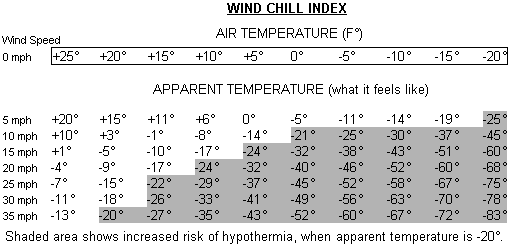"Running In The Cold"
by Mindy Solkin
The human body maintains a core temperature of about 98.6 degrees Fahrenheit. The control center for body temperature is the hypothalamus in the brain. This control center receives information about the temperature of the different areas of the body. It also receives information from receptors in the skin and the spinal cord. When the air temperature is lower than the body temperature, the body loses heat to the environment. The body's natural metabolic heat production is usually sufficient to replace lost heat and maintain a normal core body temperature.
HYPOTHERMIA
However, when the environment is severe enough, the body has insufficient protection from heat loss and thus the core body temperature can drop. When it drops to 97 degrees, hypothermia occurs. Symptoms of hypothermia includes excessive shivering, euphoria, confusion and behavior that resembles drunkenness. If core temperature continues to fall, there is lethargy, muscular weakness, disorientation, hallucinations, depression or hostile behavior. If body temperature dips below 88 degrees, the situation becomes fatal.
WIND CHILL INDEX
By taking precautions such as knowing the wind chill index and dressing appropriately, you can combat any chance of hypothermia. The wind chill index (see chart) takes into account the actual air temperature and the current wind conditions. These two numbers join together to form the apparent temperature (what it feels like). Because wind accelerates heat loss by increasing the degree to which the warmer insulating air layer which surrounds your body is constantly being replaced by cooler air, the wind can cause significant cooling of your body. As a basic rule, if the wind chill temperature is colder than minus 20 degrees, there is an increased risk of hypothermia.

WINTER APPAREL
The layering of winter running apparel becomes your best line of defense against cold weather conditions. For your upper body, there are three basic levels of layering. The first or base layer should absorb perspiration and transport it away from your skin to the outside where it evaporates into the air. This layer should be lightweight and fit snugly to keep your skin dry. The second or middle layer serves as a heat insulator by trapping some air to keep you warm, yet releasing enough vapor or heat to avoid overheating. And the third or outer layer performs double-duty by being breathable and water-resistant. This layer, usually in the form of a jacket, should protect you from wind, rain and snow. Depending on the wind chill temperature, you may not always need all three layers. Usually, two of the three layers are sufficient but this becomes a personal decision.
Since your hands and feet act like a chimney for your body, a high percentage of heat escapes through them. Therefore it is also important to wear gloves or mittens (mittens help keep your hands warmer since your fingers warm each other); hat or headband; and breathable socks to keep your feet warm and dry.
THE PHYSIOLOGY OF RUNNING IN COLD WEATHER
Your ability to exercise will not be impaired provided you maintain normal body temperature. However, if core temperature and muscle temperature fall below normal levels, the following may occur during your run:
- Maximal aerobic capacity may be reduced
- Heart rate may be slightly lower
- Stroke volume (the amount of blood pumped by your heart per beat) tends to be higher at low exercise intensities, but not at higher workloads
- Cardiac output (the amount of blood pumped by your heart on a per minute basis) remains unchanged
- Fast twitch muscle fibers (the fibers you recruit to run fast or sprint) may be adversely affected since cool muscles have a diminished ability to generate force
The good news is that the more aerobically fit you are, the better. During exercise, more than 75% of the energy produced by the working muscles is converted to heat, which in turn elevates your core temperature. When your exercise intensity is moderate to high, you are able to generate a sufficient amount of heat to maintain your body's normal temperature range. However, at low intensities, your body's core temperature could start to fall after one hour of exercise in the cold, whereby the onset of involuntary shivering takes over inducing body heat to keep you warm.
The key to running safely outdoors in cold weather is to be prepared by wearing the proper clothing for the apparent temperature conditions. Today's running apparel allows for a vast array of options to keep you warm and dry in all elements.
|





